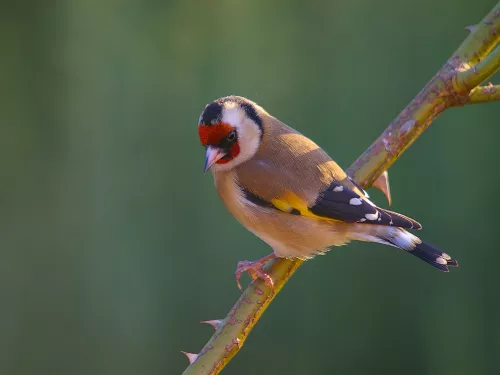Glanville fritillary
The Glanville fritillary can be spotted on warm days around coastal habitats on the Isle of Wight and the Channel Islands, as well as at a few locations in mainland England.
The Glanville fritillary can be spotted on warm days around coastal habitats on the Isle of Wight and the Channel Islands, as well as at a few locations in mainland England.
This glossy wading bird is a scarce visitor to the UK, though records have become more common in recent decades.

The glow-worm is not actually a worm, but a beetle. Males look like typical beetles, but the nightly glow of a female is unmistakeable - lighting up to attract a mate in the darkness of their grassland habitats. Look for the adults in summer.
One of our commonest willows, the Goat willow is a small tree that is found in ditches, reedbeds and wet woodland. It is well-known for its silver, fluffy catkins that give it another name, 'Pussy willow'.
A king among birds, the goldcrest displays a beautiful golden crown. Our smallest bird, it can be spotted in conifer woodlands and parks across the UK.
From spring, look out for the beautiful, speckled gold-and-black breeding plumage of the golden plover. It can be found in its upland moorland breeding grounds from May to September, moving to lowland farmland and fields in winter.
This beautiful beetle is fond of damp meadows and woodland rides, where it's often found on umbellifers or thistles.
A voracious predator that will even eat other dragonflies, the golden-ringed dragonfly is the UK's longest species. It can be found around acidic streams in moorland and heathland habitats.
A medium-sized diving duck, the goldeneye can mainly be spotted in winter when birds fly in from Northern Europe. Conservation efforts have helped small numbers of these birds to nest in Scotland.

The striking red crown, golden back, and bright yellow wings of the goldfinch make it one of our prettiest garden birds. It happily visits birdtables and feeders across the UK.
The streamlined goosander is a handsome bird and a great fisher - its long, serrated bill helps it to catch and hold its slippery fish prey. It nests in riverbank trees, but can be seen on lakes and reservoirs in winter.
Goose barnacles often wash up on our shores attached to flotsam after big storms.